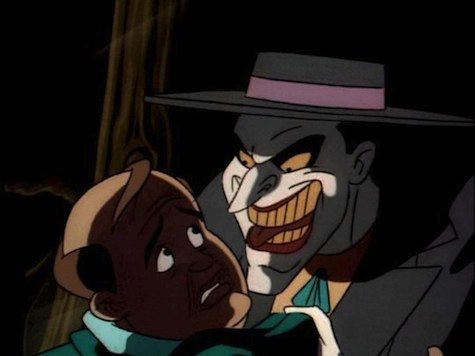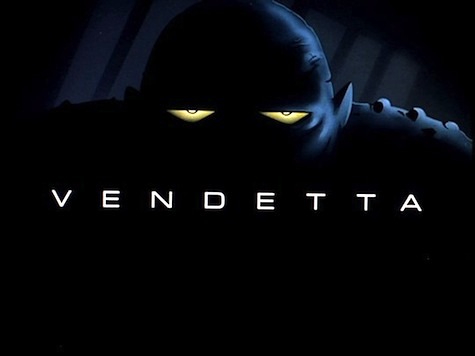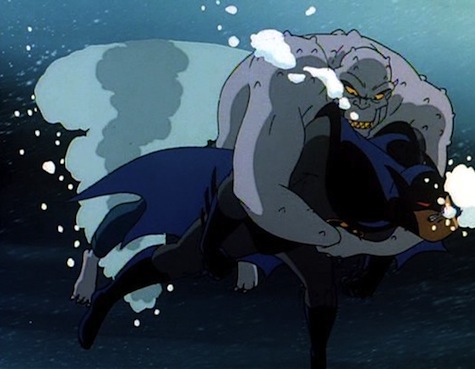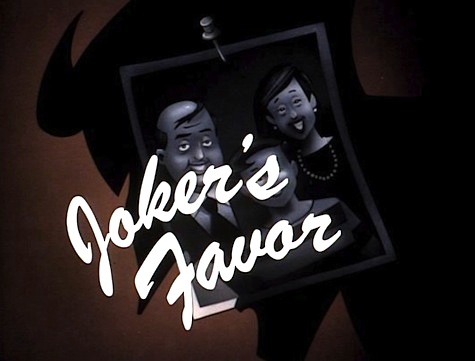“Joker’s Favor”
Written by Paul Dini
Directed by Boyd Kirkland
Episode #022
Music by Shirley Walker
Animation Services by Dong Yang Animation Co., LTD.
Layout Services by NOA Animation
Original Airdate – September 11th, 1992
Plot: Two years ago, the Joker spared Charlie Collins’s life. Now, on the eve of a banquet honoring Commissioner Gordon, the Joker calls in his favor.
“Joker’s Favor” is another one of my favorite episodes of The Animated Series. Charlie Collins, Ed Begley Jr.’s second great guest performance in a row, makes a wonderful everyman: pudgy, bald with a pathetic attempt at a combover, and his own ‘50s sitcom theme music, courtesy of Shirley Walker. He’s a whiner and a loser, but he’s not a bad guy. He risks his life to protect his family and he’s surprisingly resourceful, basically inventing the Bat signal within the show’s continuity. So the story of this likable sadsack caught in the terrifying world of Batman is a great follow-up to “Be a Clown,” an adult’s take on the Joker in contrast to a child’s. Whereas Jordan Hill saw the Joker as an immediate monster, once vanquished gone forever, the Joker is a looming presence in Charlie’s life, a constant threat to his family.

Mark Hamill’s portrayal of the Joker is especially psychotic in this episode. Not only has his hatred shifted inexplicably from Batman to the Mayor and to Gordon, he has obsessively tracked one man for two years only to off-handedly try to kill him in a plot to kill someone else. He’s delightfully dickish throughout, making a big show of signaling after Charlie chews him out for cutting him off, throwing two cents at Charlie to call him on his bluff, greeting Charlie like an old friend, then making sure Charlie is mobile but trapped before the explosion (unlike the rest of the police), just so Charlie can beg for his life. He’s an unmotivated villain, one who wants to hurt people for no better reason than to hurt them.
In the end, however, we learn that the Joker is just a bully and a coward at best. His power comes from the fear he causes before he attacks, creating the false impression that only Batman can stop him. But while Batman is running though a recreated temple (complete with death traps!), it’s Charlie who punches the Joker and threatens him with a bomb until the Joker begs for his life. Of the Joker episodes so far, this is by far his most satisfying defeat. He doesn’t escape or trip, he’s outwitted and out-joked, and by a “nobody” at that.

Okay, the real story of “Joker’s Favor” is that it’s the first appearance of Harley Quinn, easily the most popular character created for the series (suck it, Sewer King!). I’ll get into a discussion about my complicated feelings about her character later, because she’s barely in this episode, she’s not quite fully formed here, has only a few lines and the one about being a beauty school drop-out is later contradicted. On the other hand, you can see the character she’s going to become. Following up the theme from “Be a Clown,” the Joker has recruited a mini-Joker as his biggest fan, another costumed villain who laughs at every joke he makes, even and especially the terrible ones. What’s missing is just how dark their relationship really is, but we’ll get there.

“Vendetta”
Written by Michael Reaves
Directed by Frank Paur
Episode #023
Supervising Composer Shirley Walker
Music Composed by Michael McCuistion
Animation Services by Spectrum Animation Studio
Original Airdate – October 5th, 1992
Plot: When witnesses against Rupert Thorne disappear, Batman suspects Detective Harvey Bullock is behind it. But Harvey is being framed a monstrous reptile man who has a… what’s the word? Starts with V….
My biggest problem with “Vendetta” is that it’s not “A Bullet for Bullock.” Since the pilot, Bullock has been a thorn in Batman’s side, calling him out on stealing evidence, attacking cops, and taking the law into his own hands. And here Batman is straight-up wrong about Bullock’s guilt and almost puts an innocent man in jail. Had Batman interrogated Bullock as he does Thorne, roughing Harvey up in his own home and throwing him off a roof, Reaves and Paur could have shown that Bullock has a real point and there should be limits on what Batman does.
Additionally, they could have demonstrated Bullock’s actual redeeming qualities. Gordon says Bullock is a good cop, but we don’t see it. It’s implied Bullock is someone to respect, as Killer Croc nearly kills Batman, and Bullock managed to arrest this monster without Batman’s help two years earlier (perhaps while the Joker was not killing Charlie Collins). Had Bullock helped in the climatic fight at the end, the episode could have ended on a note of mutual respect. But instead he’s unconscious and so we don’t. (At least Batman admits he was wrong). For an episode revolving around him, Bullock is singularly passive the whole time.

That said, it’s a little unfair to criticize this episode for not being a different one. The story it chooses to tell it tells very well. Michael McCuistion’s tense, moody score is solid throughout. Spectrum Animation brings their A game to Frank Paur’s noirish direction of neverending rain, shadowy bridges, and dark, menacing caves. And the fight in the sewer at the end is a bruising affair between a master martial artist and a much stronger monster.
Additionally, the introduction of Killer Croc is great. No time is wasted explaining why he’s a super strong reptile man, just that he is and he’s back for revenge. In later episodes Aron Kincaid will play Croc as a buffoon, but here Croc is patient, vicious, and even clever. Framing the cop who arrested him for killing the witnesses who testified against him is brilliant in its simplicity. And that’s before he nearly beats Batman to death in the sewer, making him on par with Clayface and Mr. Freeze as physical threats.
Not to say there aren’t Fridge Logic problems with Croc’s plan: Does a crocodile man in a trench coat really look like Harvey Bullock? How could he leave a scale when his whole plan involved the police finding a planted toothpick? The worst question is why does he keep Spider Conway and Joey the Snail alive? The answer “It’s a kid’s show” doesn’t quite sit right, as the menacing shot of Croc moving in on a screaming Conway implies he was doing something to them in that cave, and torture is the least awful thing I can think of.

(By the way, Spider Conway is named after Killer Croc’s creator, Gerry Conway.)
Also, this is another episode of Batman being a really terrible detective. Not only does he suspect Bullock on very little evidence, it takes forever for Batman to tie the human reptile scale he finds to a crocodile man on record as having a vendetta against Bullock, Conway, and Joey the Snail. He doesn’t check Bullock’s arrest record, ask the zoo’s reptile expert if they know anything, or even ask Kirk Langstrom if he’s been working on any sort of “Man-Crocodile.” He goes to a children’s exhibit at “not-Sea World” to find out crocodiles live underwater. It’s one of the stupidest things in the entire series, so out of tune with the dark crime fiction tone of the rest of the episode that it stands out like, well, a giant grey reptile man in a trench coat.
Steven Padnick is a freelance writer and editor. By day. You can find more of his writing and funny pictures at padnick.tumblr.com.











Worth noting that “Joker’s Favor” was Paul Dini’s first Joker episode, and it’s a quantum leap above the previous ones in quality (which is why this was the first Joker episode aired). Dini did an amazing job with the character, making him both genuinely scary and genuinely funny at the same time, so that you laughed out loud at his antics and felt uncomfortable doing so. And Dini also introduces a thread here that he revisits later on: the revelation that beneath all the Joker’s bombast, he’s really a pathetic, hypocritical being, a mere bully who enjoys laughing at others’ expense but, for all his pretensions of clownhood, can’t stand being the butt of anyone else’s joke. Dini’s perhaps best remembered for inventing Harley, but that sometimes overshadows how important he was at reinventing the Joker — or perhaps distilling his essence.
It’s also great that Dini lets Charlie be the hero of the piece and get out from under the Joker’s tyranny through his own efforts. Though I imagine that if the Joker weren’t so mercurial, he probably would’ve had Charlie and his family offed as soon as he got the opportunity. Well, maybe Batman helped them change identities again.
Charlie’s appearance was modelled on B:TAS producer Alan Burnett, much as the villain in “Beware the Gray Ghost” was modelled on Bruce Timm. And Harley’s personality was based on Dini’s friend Arleen Sorkin, who of course played the role.
“Vendetta” isn’t as memorable. It’s very well made, but the story is mediocre. As for Croc becoming more of a bufoon later, that’s more on Dini than Kincaid. In Dini’s “Almost Got ‘Im,” Croc was played as a buffoon, although (spoiler) that turned out to be Batman in disguise as Croc — proving once and for all that Batman does have a sense of humor. Yet Dini called that portrayal back when he wrote Croc again in “Trial.” Still, he was more his old self in “Sideshow,” Reaves’s return to the character.
What always gets me about the scene where Croc impersonates Bullock’s voice is that it’s Robert Costanza being all growly, rather than Aron Kincaid imitating Costanza. There’s kind of a logic problem there.
Regarding Harley, during the rewatch of the Superman serires it seemed to me, that every archvillain in the DCAU needed a hench-woman, with whom they have a clearly abusive relationship. (One can argure that Mercy outfit is just as much the symbole of submission, that the outfit of Harley.)
Also, if we are on the topic of Superman, that shows detective, Dan Turpin was clearly to show that:
1) You do not have to be a superhero to stand up for justice
2) Superman does not rivalise with other authorities, but wishes to fight side-by-side with them.
(I also liked, that there was a “metaplay”, that Superman’s presence makes Dan Turpin obsolete in the eyes of public opinion, which frustrates him, and yet in the end of that particular episode, they ends up as friends, who fight on the same side.)
But that is another series, I know…
Man, that bit where Bruce Wayne goes to the zoo to figure out where crocodiles live is hilariously dumb. This show should be better than that.
Particularly dumb given the computer in the Bat Cave.
Which reminds me — Did they ever show a Library in Wayne Manor? There should’ve been a really big one there!
Joker definitely needs a new hobby. I enjoyed this episode it shows how scary it would be for anbody in Batman’s world to notice you. I’m glad Charlie is finally able to face and defeat the Joker, and with one of his own bombs!
Batman is a terrible detective in Bullocks episode. I think Wayne manor has a library or at least a lot of books. If you couldn’t use the super computer in the basement why not an old fashioned encyclopedia? The zoo was a good thought but executed badly. On the Bullock himself just because someone disagrees with your methods doesn’t make them a bad guy. Gordon trust Bullock and Batman trust Gordon. Batman’s investigation comes off as dislike not doubt about the cop’s motives.
Oh, man! “Joker’s Favor” has stuck with me in the decades since I saw it. The poor guy is in such a fix, but rises to the occasion. Swear to god, to this day I occasionally find myself wondering, as I drive on dark city highways, what I’d do in Charlie’s situation.
This adventure, and the “Silicon Soul” mini-arc, are what convinced me that B:TAS was a work of love and genius. Growing up in the ’60s and early ’70s, we got crap. All that loud, shticky Hanna-Barbera stuff, and Filmation mediocrity. Kids in the ’90s got the revived and reinvented H-B, and Batman, and the insane WB ‘toons.
@6: On the other hand, a lot of the people who were responsible for the ’90s animation renaissance cut their teeth working for Filmation and Hanna-Barbera. The ’90s shows wouldn’t have been what they were if they hadn’t been able to stand on the shoulders of their predecessors. Bruce Timm and Paul Dini both started out working on Filmation shows, notably He-Man. Alan Burnett came from H-B, and it was his episode “The Fear” on the final season of the revamped Superfriends franchise that helped pave the way for B:TAS by handling Batman intelligently in animation (and telling his origin story for the first time outside the comics).
I’d get used to Fridge Logic and out-of-character Batman. If you’re
going to watch the entire series then you’ll see it cropping up more and
more in TNBA. I watched the whole series over the past week… never
did get to see the TNBA as a kid. I guess I wasn’t missing much.
Nothing to add about “Joker’s Favor”. It’s a very slick episode like
“Worry Men” and “Fire from Olympus”. It’s just a well done episode with just enough depth to keep it fresh with a re-watch.
Croc never was very compelling as a villain in TAS. Probably because his psychology was never really fleshed out or expanded upon. He’s your basic born bad monster… and he’s not particularly bright when compared to Batman. He’s okay for standalone story or a rogue team-up, but not so good as recurring villain. We know very little of Croc’s childhood, he doesn’t talk about himself much, and the TAS writers usually only pull him out of the bag when they need someone with brute strength to pummel Batman when Batman-Muscle-Rogue X isn’t unavailable. Talk about dull. They do attempt to give him some depth in a later episode related to the circus…. but it’s not enough. He just never struck me as particularly interesting Batman rogue — at least in TAS. I have no idea what heights (or depths) he reached comics.
It’s the same story with Firefly. Firefly could have been a great
villain if we explored his psychology more. But unfortunately, as with
Croc’s character, the writers focused on the gimmicks rather than
psychological make up and motivations.
Not all Hanna Barbara stuff was bad. The Herculoids was far and away my favorite.
As far as Killer Croc goes, I actually feel The Batman did a better job with the character, much as I love TAS more.
(Ditto for the Riddler, who TAS seemed to really struggle with. In contrast, The Batman seemed to make the whole genius Harlequin Death Rocker thing work.)
@10: I loved The Batman‘s origin episode for the Riddler, “Riddler’s Revenge,” written by DC Animated Universe veteran Stan Berkowitz. It felt more like a B:TAS-style origin story than B:TAS’s own Riddler debut did.
The problem with writing for the Riddler is that the writer has to be clever enough to come up with good riddles and mind games. The first two B:TAS Riddler episodes had really stupid riddles and were too dependent on computer games in an attempt to update the character and make the stories more action-oriented. The third one, which I think was called “Riddler’s Reform,” was much better.
Yeah, the initial episodes focused too much on his gimmicks and not on his brainpower.
Chris Yost (best known now for now for The Avengers: Earth’s Mightiest Heroes) co-wrote a follow-up story that managed to make The Batman’s incarnation of Mister Nigma a credible challenger to the Joker and the Penguin for Gotham’s King of Costumed Crime.
Riddler’s Reform was a great TAS episode, bringing out as it did Nigma’s genius and his ultimate obsession.
(The Batman Adventures TAS spin-off comic did much better with the character.)
Please excuse my fragmentary, incoherent rambling. Growing up with Frank Gorshin’s brilliant depiction of the character (smart, vain, funny, and very cruel beneath the games…it’s no surprise Mark Hammill based his Joker on that take), the Riddler holds a special place in my Bat-fan heart.
@13: Yeah… the methodology of Gorshin’s Riddler didn’t really stand out in a series where most of the villains left elaborate wordplay-based clues lying around for Batman and Robin to decipher, but it was his mercurial personality — the blend of mirth and menace, goofiness and sophistication — that made him memorable.
This article is missing from the series page